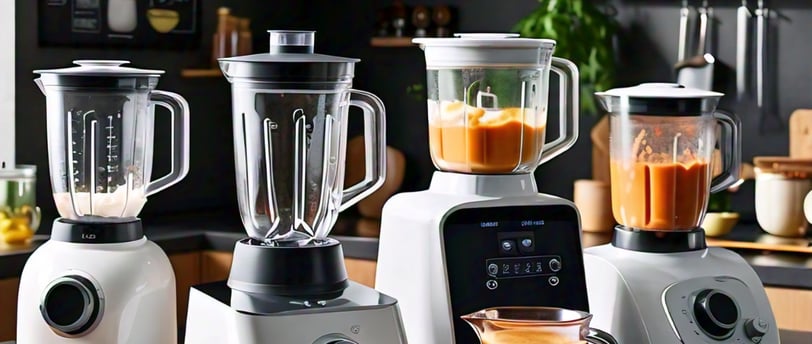The Ultimate Guide to Blenders: Choosing the Best Blender for Your Kitchen
Disclaimer: As an Amazon Associate, I earn from qualifying purchases. This post may contain affiliate links. Blenders are the ultimate kitchen sidekick, perfect for creating everything from creamy smoothies to hearty soups and zesty sauces. But with so many options out there, finding the right one can feel like navigating a blender jungle! Don’t worry—we’ve got you covered. In this guide, we’ll walk you through the must-know tips for picking the perfect blender and share top recommendations to suit any need or budget. Let’s get blending!.
BLOG
9/8/20243 min read


Blenders are essential kitchen gadgets for whipping up smoothies, soups, sauces, and much more. But with so many options on the market, choosing the right blender can be overwhelming. In this guide, we’ll dive into the key factors to consider when buying a blender and recommend some top choices for different needs and budgets.
1. Types of Blenders
Blenders come in different types, each designed for specific purposes. Understanding the differences can help you pick the best one for your kitchen.
Countertop Blenders: The most common type, ideal for everything from smoothies to soups. These blenders come with a pitcher and are perfect for larger batches.
Personal Blenders: Smaller, single-serving blenders that are great for on-the-go smoothies and shakes. They usually come with a travel lid for convenience.
Immersion Blenders: Also known as hand blenders, these are compact and ideal for blending soups, sauces, or small amounts of ingredients directly in a pot or bowl.
High-Performance Blenders: These are powerful blenders that can handle tough tasks like crushing ice, making nut butter, or blending hot soups.
2. Key Features to Look For
When shopping for a blender, keep an eye out for the following features:
Power (Wattage): The higher the wattage, the more powerful the blender. Look for at least 500 watts for general use, but opt for 1000+ watts for heavy-duty blending.
Blade Material: Stainless steel blades are the most durable and effective for cutting through tough ingredients.
Pitcher Material: Blenders often come with plastic, glass, or metal pitchers. Plastic is lightweight but can scratch easily, while glass is heavier but more durable and scratch-resistant. Metal pitchers are durable but limit visibility.
Speed Settings: Multiple speed options give you more control over your blending, especially for different textures. Pulse settings are also a bonus for precise blending.
Capacity: Consider how much you’ll be blending at once. A standard blender pitcher holds around 48 to 64 ounces, while personal blenders have smaller capacities (around 16 to 24 ounces).
3. Top Blender Recommendations
Here are some of the top-rated blenders across different categories, based on customer reviews and performance.
Best Overall: Vitamix 5200
The Vitamix 5200 is a high-performance blender known for its powerful motor and durability. It’s perfect for serious home cooks who need a versatile machine that can handle everything from smoothies to soups.
View on AmazonBest Budget: Ninja Professional Blender
For those looking for a reliable blender at an affordable price, the Ninja Professional Blender delivers solid performance without breaking the bank. It has a powerful 1000-watt motor and a large 72-ounce pitcher.
View on AmazonBest Personal Blender: Ninja Nutri-Blender Pro with Auto-iQ
The Ninja Nutri-Blender Pro is perfect for quick, single-serving smoothies. Its 1100-watt motor handles frozen fruits, veggies, and ice with ease, while the Auto-iQ technology offers pre-set blending programs for convenience.
View on AmazonBest Immersion Blender: KitchenAid Variable Speed Hand Blender
The KitchenAid Variable Speed Hand Blender delivers top-tier performance for soups, sauces, and more. Its compact design offers excellent control, and it includes a variety of attachments for versatile kitchen use.
View on Amazon
4. Tips for Maintaining Your Blender
To keep your blender running smoothly for years, follow these maintenance tips:
Clean Immediately After Use: Blenders are easiest to clean right after use. For stubborn stains, blend warm water with a few drops of dish soap, then rinse.
Avoid Overfilling: Never fill the pitcher beyond its capacity to prevent leaks and ensure smooth blending.
Sharpen or Replace Blades: Over time, blades can dull. Some blenders allow you to replace blades, or you can sharpen them if needed.
Check Seals and Gaskets: Regularly inspect seals and gaskets to make sure they’re in good condition to avoid leaks.
5. Conclusion: Which Blender is Right for You?
The right blender for you depends on your cooking habits and preferences. If you’re an avid cook or need a blender for a variety of tasks, a high-performance blender like the Vitamix 5200 is worth the investment. For casual use, a budget-friendly option like the Ninja Professional will get the job done without compromising on quality.
Whichever blender you choose, investing in a good-quality machine will save you time and hassle in the kitchen!
Cooking
Bringing Out the Chef in Every Home.
contact@ezcookingguide.com
© 2024. All rights reserved.


